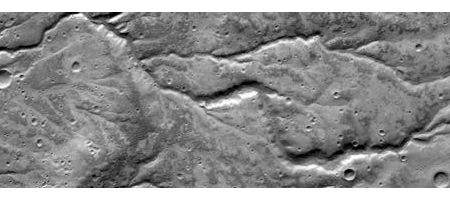The channels on Mars widely supposed to have been created by flowing water have a completely different origin, says a Texas Tech University professor.

David Leverington says that an examination of , an associate professor in the Department of high-resolution photographs and mineralogical data shows that the largest ‘ancient riverbeds’ on Mars most likely were created not by water, but by massive, fast-moving, low-viscosity lava flows.
“Many scientists realize there are issues with aqueous interpretations of these channels,” he says.
“They recognize that if these systems formed by giant subsurface flows of water, there would need to have been extraordinarily high ground permeability, up to a million or more times greater than what we’d expect for the crust of the Earth, just to allow sufficient amounts of water to make it to the outflow locations and erupt to the surface.”
While water exists on the planet, most of it appears to be trapped at the poles and at higher latitudes in the form of ice. And, according to Leverington, it’s unlikely that there’s enough water elsewhere on the planet to have created the channels.
The Martian outflow channels superficially resemble channels on Earth formed by floods from giant glacial lakes. However, unlike Earth’s water-formed channels, the large Martian canyons don’t feature obvious river deposits and don’t terminate in delta-like, sediment-laden mouths. Instead, they fade into vast plains composed of volcanic basalt.
“We see abundant evidence for past eruptions of lava at the heads of these large systems, for flows along these systems and for extraordinarily large volumes of lava at the mouths of these systems,” he says.
“These characteristics are very similar to what we see at volcanic channels on the moon and on Venus. There’s really no known process for the rapid eruption of large amounts of water from aquifers to form channels that are thousands of miles long. We do have evidence of this happening through past volcanic processes on the moon and Venus.”
To back this up, Leverington says that many minerals found around the largest martian channels show no signs of having been altered by water.
“Some ancient exposed bedrock contains large amounts of iron-rich olivine, and that has not been altered in the past 3.5 billion years. That would suggest that most of Mars history has been extraordinarily dry,” he says.
“Surface conditions were likely to have been relatively wet in large regions only in Mars’ earliest development stages. These wet stages pre-date the development of the large outflow channels on Mars.”
But this doesn’t mean that life on Mars couldn’t have developed, he says.
“There’s still the potential for life to have developed and even flourished in the earliest and wettest stages of Mars’ history,” Leverington says.
“Simple life forms, such as bacteria-like organisms, could have lingered in the subsurface under the dry conditions that ultimately became widespread. But if the large outflow channels formed through volcanic mechanisms rather than substantial water flow, that mainly restricts the environments conducive to the development of life to the earliest stages of that planet’s history.”






